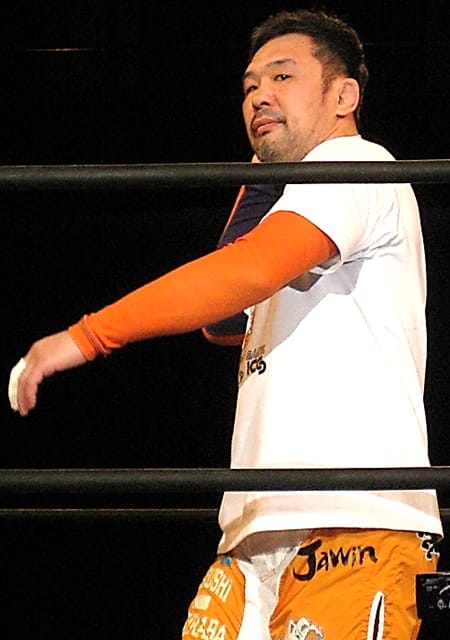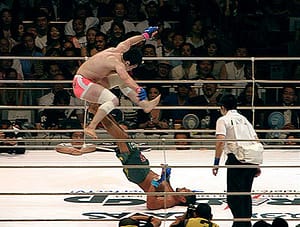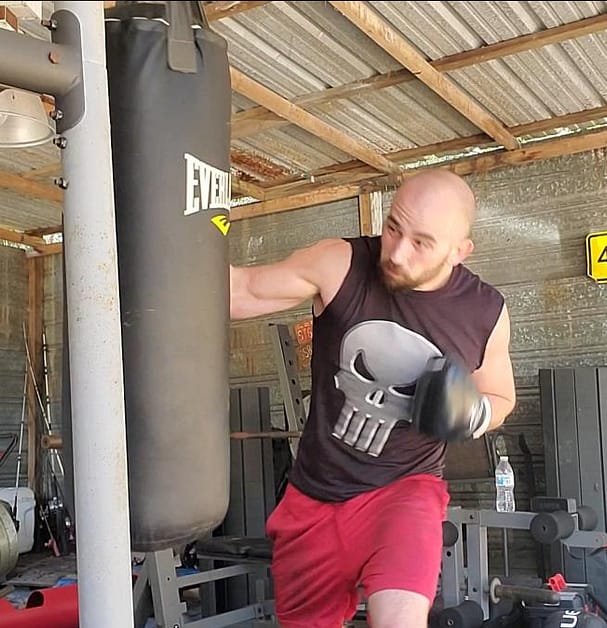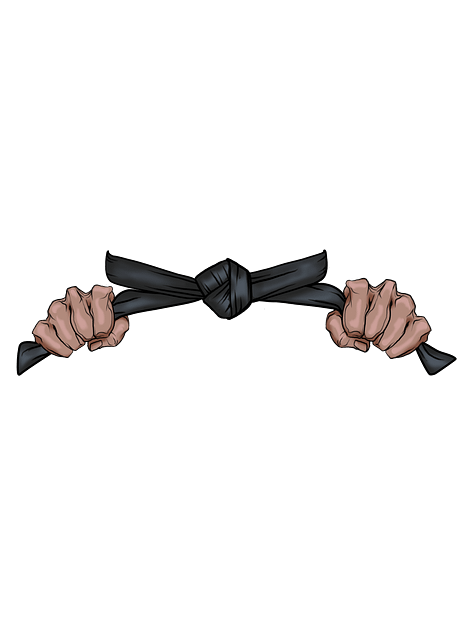
In my previous article about catch wrestling, I briefly touched on a few notable practitioners. The first I mentioned was a man known as Kazushi Sakuraba. Kazushi Sakuraba is not only one of my favorite fighters ever, but he may be the most important figure in Japanese pro mma history.
Because of this, I’ve decided to begin another series that will allow me to go deeper into these fighter’s histories and accolades. It’s only natural that I start with Sakuraba, as it’s very likely that without him, Pride would have been a shadow of the organization it became.
Early Years and Amateur Wrestling
As I touched on in the previous article, Sakuraba began his career in amateur wrestling at fifteen years old. He stood out in high school, finished second in the nation, and then joined the Chuo Univeristy wrestling squad. It was there that he would hone his amateur wrestling among Olympic gold metalists, and serve as the team captain.
In his senior year, he finished fourth place in the All-Japan tournament. His most notable win was a defeat of a future Olympic bronze medalist, Takuya Ota, shocking even himself with the victory.
Upon finishing school, Sakuraba then planned on coaching at Chuo University. At the last minute, though, Sakuraba decided to instead chase his life long dream of being a pro wrestler. According to him, he made the decision due to wanting to be like the pro wrestler Satoru Sayama, who portrayed the Japanese hero Tiger Mask.
Kazushi Sakuraba’s Catch Wrestling Days
A friend informed Sakuraba that they had the phone number of someone in a shoot style wrestling gym. And though Sakuraba would never try out for that gym, he ended up answering a call for talent try outs with the UFWI pro wrestling promotion, another shoot style promotion.
It was here that he ended up under the tutelage of Billy Robinson, and that he received his initial instruction in catch wrestling. And as it turned out, it was catch wrestling that would serve as his base that would later lead to his success in the Pride Fighting Championships.
At these infamously tough try outs, Sakuraba was forced to shed his reputation of cheating during workouts. And though he suffered phsycially, the young Kazushi would eventually be accepted. He’d stay with the program until 1996, in a rather unremarkable stint of professional wrestling.
More valuable would be his catch wrestling training under Billy Robinson. During this time, Robinson would tutor Sakuraba in the catch wrestling style, and he took to it well. His skill in the style grew quickly, but the politics of pro wrestling and the fact that grappling is not the only factor in advancement would lead to him simply serving as a middling talent there.
Early Mixed Martial Arts Career
Though many people believe that Sakuraba’s match with Kimo Leopoldo on July 14th in 1996 was his first fight, his first contact with the sport of MMA can actually be traced to June of the same year against Rene Rooze, who Sakuraba beat via a catch wrestling ankle hold.
Kazushi then ended up in line to compete in the Ultimate Japan Tournament, hosted by the UFC. He served as a late hour substitute for a fellow pro wrestler named Hiromitsu Kanehara. Sakuraba actually lied about being heavy enough to compete, claiming that he was 203 pounds despite only walking around at about 180; as the tournament was only for heavyweights.
His first fight was against a 240 pound Brazilian jiu-jitsu blackbelt and former Extreme Fighting champion, Marcus Silveria. The two grapplers battled with leg locks and no decisive action initially. Upon standing up, a fury of light blows by Silveira forced Sakuraba to drop for a low single leg, but referee Big John McCarthy stopped the fight early, believing Saku had went down due to the punches.
Upon tape review, the decision was changed to a no-contest. But by that time, Tank Abbott had dropped from the tournament after injuring his hand. It was then ruled that Sakuraba and Silveira would face off once again in the championship bout.
Silveira opened their second match taking Sakuraba’s back, which the Japanese wrestler answered by attempting to apply a Kimura lock. After freeing his arm, Silveira capitalized on another Kimura attempt by Saku to try to twist it into an armbar from his guard, only for the Japanese to escape to his knees. Silveira then tried his own Kimura, but at that moment Sakuraba reversed it in the same way and locked the armbar, making the Brazilian submit. After this fight, Sakuraba famous stated one of my favorite lines in MMA history, “In fact, professional wrestling is strong.”

Pride Fighting Championships
Sakuraba would come to forge the legend we all know in love entering the Pride Fighting Championships in the stead of a stablemate’s defeat and the hand of Rickson Gracie. Pairing off first against Vernon White, Sakuraba was quick to take him down and relentless in submission attempts, eventually catching him in an arm bar in the third round, showing his catch wrestling skills once again.
In Pride 3 Sakuraba would return, this time against Carlos Newton. The match was a back and forth grappling affair between the two talented grapplers, eventually leading to a catch wrestling style rolling knee-bar by Sakuraba. This would see the fight to it’s end as he submitted Newton. In the next event, a heated battle would see a draw between Sakuraba and Allan Goes.
His notoriety truly began as he became “The Gracie Hunter”. After defeating Anthony Macias, Sakuraba would find himself matched against Royler Gracie, who had beaten a stablemate of his; Yuhi Sano. This was one of few fights that actually saw Sakuraba enjoying a weight advantage.
Royler, unable to score a takedown or strike effectively from a standing position, remained on the ground in an effort to bait Sakuraba into a grappling-oriented contest, while Sakuraba, standing, landed punishing kicks to Royler’s legs, thighs and head. Eventually, with less than two minutes remaining, Sakuraba finally engaged Royler on the ground and instantly caught him in a Kimura lock. As Sakuraba wrenched on the submission, the referee intervened with 1 minute and 44 seconds remaining on the clock, ending the contest and awarding Sakuraba the win by TKO.
In doing so, Sakuraba handed the Gracie family their first pro fighting less in decades, and sent ripples through the world of MMA. Sakuraba was the first Japanese athlete to defeat a Gracie since the legendary Mashahiko Kimura, who the technique he had used to beat Royler was named after.
The Legend
This lead to Sakuraba becoming a superstar to MMA fans in and out of Japan. Rivalries with the entire Gracie family, Pride Grand Prix tournaments, and fights with some of the best to ever step into the Pride ring only cemented that fact. As Pride collapsed in the late 2000’s, Sakuraba engaged in small rivalries with other current or former pro wrestlers, and experienced a short renaissance in the mid-2000’s. He lost a rematch with Royce Gracie in 2007, but when Gracie tested positive for steroids that result was overturned in the eyes of many fans. It wasn’t until 2010, when Ralek Gracie won a decision over Sakuraba, did the Gracies finally get a small measure of revenge. That loss came in the midst of 2-6 run that caused Sakuraba to retire from Mixed Martial Arts.
His lack of success in his late career did nothing to sabotage his legend, though, and to this day he’s still one of the most loved catch wrestlers to ever make the jump into MMA. Kazushi “The Gracie Hunter” Sakuraba.


